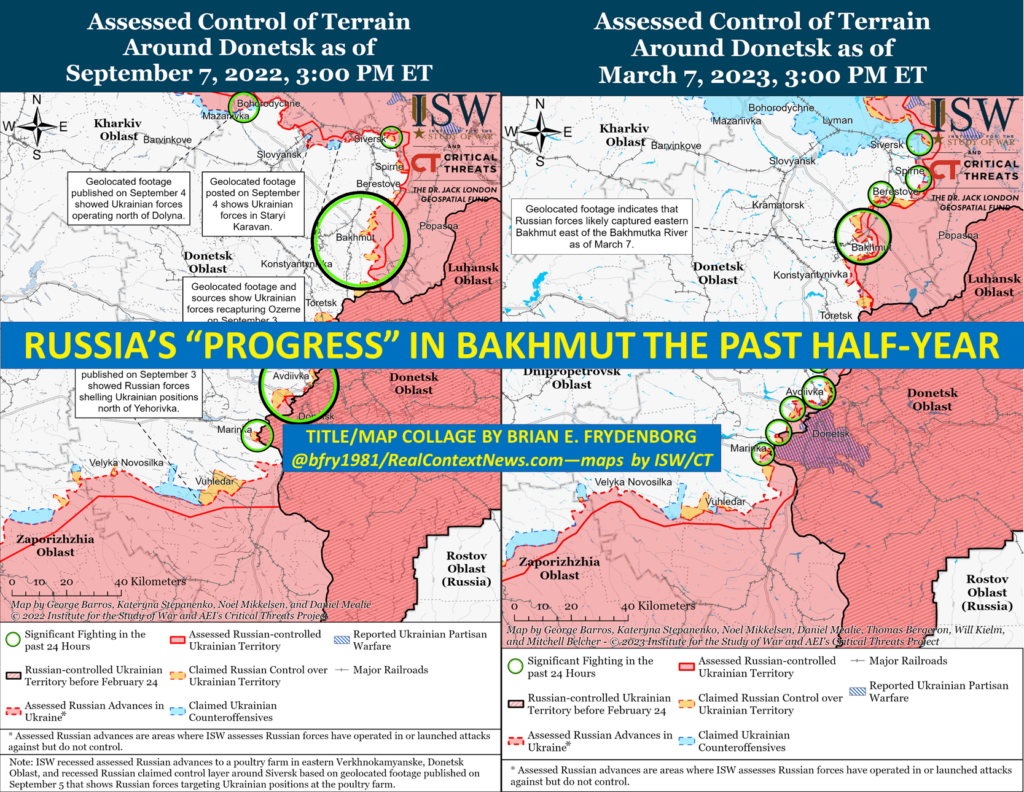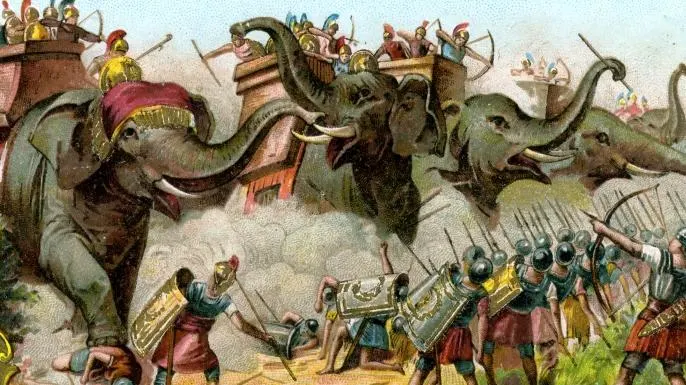Many analysts seem focused on whether proclamations by Russia that it has “won” the battle for Soledar are accurate or how accurate. The bigger picture here shows that regardless, Russia is setting itself up for a titanic defeat because of its insanely Pyrrhic tactics, and to understand what that really means, it is worth looking into the definition of “Pyrrhic”
(Russian/Русский перевод; Если вы состоите в российской армии и хотите сдаться Украине, звоните по этим номерам: +38 066 580 34 98 или +38 093 119 29 84; инструкции по сдаче здесь)
By Brian E. Frydenborg (Twitter @bfry1981, LinkedIn, Facebook) January 13, 2023; updated March 7, 2023 to include new 6-month map of Russia’s Bakhmut-area “progress;” because of YOU, Real Context News surpassed one million content views on January 1, 2023, but I still need your help, please keep sharing my work and consider also donating! Real Context News produces commissioned content for clients upon request. See related January 14 article, THE TWO MAPS SHOWING WHY RUSSIA’S BAKHMUT CAMPAIGN IS UNDENIABLY A MISERABLE FAILURE (including Soledar); my initial Twitter thread that inspired this article was shared and praised by none other than Lt. Gen. Ben Hodges, U.S. Army (Ret.), former commanding general, U.S. Army Europe (so much appreciation to him and he and his analysis are definitely worth following):
Update January 13: THE man to follow on logistics and equipment in the Ukraine war—Trent Telenko, one of my top 5 accounts to follow on the war—just generously plugged my initial thread…
SILVER SPRING—The eyes of the world are currently on the small town of Soledar, a suburb of the small city of Bakhmut, “every inch of which,” to quote Ukrainian President Volodymyr Zelensky’s in-person address to the U.S. Congress in late December, “is soaked in blood.” Russian advances in Soledar, just north of Bakhmut, come in the context of Bakhmut for months being the focus of Russia’s main ground offensives in Ukraine (Russia being reduced, in most other cases with its offensive activity, to primarily lobbing missiles and drones against civilian, non-military targets—civilians themselves and their water and power infrastructure—since Russia’s military remains largely ineffective against Ukraine’s actual military). Yet the massive Russian effort to take Bakhmut over these recent months has very, very little to show for it, for, as the increasingly famous meme proclaims daily, “Bakhmut Holds” for Ukraine.

Neither Bakhmut nor Soledar are significant in and of themselves; there are multiple far larger, far more strategically important cities a few hours’ drive or not even an hour’s drive away from them, but they have been made important because Russia keeps desperately attacking there and Ukraine is able to keep defending while inflicting terribly high casualties on the attackers, the Ukrainians themselves having to fight fiercely—and, even the Russians admit, bravely—as Soledar and Bakhmut are both reduced to WWII-like landscapes of rubble amidst brutal fighting that is testing the limits of both sides.
While Russia will mostly have to bring in raw conscripts from within Russia to reinforce its positions here—unless it wants to weaken other positions and invite other Ukrainian counteroffensives—Ukraine is fighting on home turf and is not reinforcing with barely-trained, barely-equipped mobilized like the Russians but with well-motivated soldiers who have been training for some time or even veterans, often equipped with newer Western weapons and equipment far superior to what their Russian counterparts field, which I have repeatedly noted before and has been the case for most of the war. Reinforcing and resupplying Bakhmut and Soledar positions, then, is a far easier proposition for Ukraine than for Russia, and the better-equipped, better-organized, better-supplied, better-trained, better-cared-for Ukrainian soldiers are also suffering far less from things like trench foot along with hypothermia and the other harsh effects of winter, additional losses that are hard to track but are certainly being sustained.
Throughout its Bakhmut campaign, Russia has been throwing hastily-mobilized, often poorly-equipped troops in what seem sometimes to be human-wave style attacks against Ukraine in Bakhmut and its small suburbs, hoping to overwhelm the Ukrainian defenders with quantity over quality, and not only has it not worked well, the Russian casualties have been staggering.
Earlier, there were more of the “normal” newly-mobilized going into the actual Russian Army and the Donetsk and Luhansk separatist militias involved, but more recently, the private Wagner Group has taken the lead in the Bakhmut area. Wagner acts as an extension of the Russian military and is led by close Putin ally Yevgeniy Prigozhin—known as “Putin’s chef”—who for many years has been a point man for Russian President Vladimir Putin on everything from pro-Trump anti-Clinton election interference against the U.S., a Russian mercenary attack against U.S. and local-American-allied forces in Syria, and, today, Russia’s “grand” campaign for the tiny city of Bakhmut.
While the 2016 election interference succeeded wildly beyond what could have been expected, on the military side of things, the attack on American and local-U.S.-allied forces in Syria ended in disaster, which is the same result, thus far, for Prigozhin’s military efforts in Bakhmut. Within the Wager forces, there are some 10,000 “regular” Wagner mercenaries leading some 40,000 recruits from the Russian prison system, prisoners convicted of all sorts of (sometimes horrible) crimes being used in quite cruel and inhumane ways that result in horrific casualties on the Russian side while achieving very little. Out of this Wagnerian/convict force, recently there have been over 14,000 casualties: over 10,000 wounded, over 4,100 killed, with over 1,000 killed in the very short time “between late November and early December,” an overall casualty percentage approaching (now probably in excess of) thirty-percent
Stupidly yet predictably for Russia, even specially-trained Russian Army forces—like these artillerists begging not to be used as mere cannon fodder—are being used as mere cannon fodder. As of today, Ukraine estimates that over 113,000 Russian military personnel have been killed in the war since February 24, an official estimate I have long argued is worth taking seriously.
On Pyrrhus and “Pyrrhic Victory”
With these attacks by Russia and the level of their costs for Russia, the word “Pyrrhic” comes to mind, which you often hear in the phrase “Pyrrhic victory”—defined by the Oxford English Dictionary as “a victory that is not worth winning because the winner has suffered or lost so much in winning it”—but I will not use that term because assigning the word “victory” to Russia’s madness in Soledar is premature; we can settle for “Pyrrhic advances” here, but the word “Pyrrhic” and common phrase “Pyrrhic victory” deserve some discussion.
The term is actually from a person’s name, a famous general from antiquity, Pyrrhus of Epirus (319-272 BCE), who, according to Plutarch, was held by Rome’s later great foe Hannibal Barca of Carthage (247-c. 183-181 BCE) to be the greatest general in history. Already in his time, Pyrrhus was an incredibly famous Greek general at a time when famous generals were sometimes found to be taking up wars upon request from other parties, and Pyrrhus was in intense demand in his day. One of these requests for aid he accepted involved the Greek state of Tarentum in southern Italy in 281 (the Greeks had colonized southern Italy centuries ago). Tarentum had found its supremacy in Southern Italy challenged by a rising power from central Italy: the Roman Republic, and the Tarentines requested aid from their fellow Greek, King Pyrrhus, just a short sail from Epirus (western Greece) across to Italy’s boot, on which Tarentum lay.

In the first clash between Rome against a mainland Greek power from the Mediterranean’s east, Pyrrhus fought two major battles against the Romans in 280 at Heraclea (Rome’s first, and disastrous, encounter with elephants in battle) and 279 at Asculum, and both seem to have been devastating Roman defeats, with Pyrrhus coming to “within two days’ march of Rome itself” (admittedly with formidable walls for defense, but still…). Yet Pyrrhus was distraught, in particular, after his second victory:
The two sides disengaged, and Pyrrhus is said to have remarked to someone who was congratulating him: “One more victory like that over the Romans and we shall be completely undone.” For by then he had lost a large part of the army he came with, and almost all his Friends and generals, who were irreplaceable. He could also see that, while the enthusiasm of his allies in Italy was waning, the Roman army was quickly and easily brought back up to strength—it was as though there were a spring that flowed straight from their home into their camp—and so far from being demoralized by their defeats, the resentment they felt towards the enemy gave them extra strength and determination (Plutarch, Parallel Lives,The Life of Pyrrhus 21).

Rome was saved at that moment by a combination of its own dogged determination but also by Pyrrhus being enticed to go to Sicily to fight on behalf of Greek cities there against Carthage (saved not likely existentially—even if that may not have been obvious at the time for the Romans—but from winning, at that time, supremacy in southern Italy, but that, in turn, could have substantially altered the trajectory of Roman and world history, especially with the Punic Wars against Carthage on the horizon, which would begin in 264 BCE over in Sicily).
Russia’s Pointless, Pyrrhic Bakhmut Campaign
But that above long quote from the ancient Greek historian Plutarch is quite relevant to the current situation in Ukraine: Pyrrhus, sustaining heavy losses even in his victories (exactly where we get the term “Pyrrhic victory”), could not easily replace the high-quality veterans and leaders he knew well and had brought over the sea with him from Greece, while Rome, fighting in Italy on its home turf, could replace its losses and reinforce far faster with men highly motivated to defend their homes, their losses only motivating them further. This dynamic is very much true for Russia fighting its imperialist war against Ukrainians in Ukraine, and it is more than fair to apply the adjective “Pyrrhic” to anything resembling a Russian victory (Mariupol) or advance (now in Soledar) after the earliest days of this current Russian escalation in Ukraine that began on February 24, 2022 (I say escalation because Putin actually started the war in 2014).
In the age of mechanized war and in light of Ukraine’s sweeping, historic counteroffensives breaking through Russian lines throughout 2022, the issue that should most concern analysts and journalists is not whether Russia has or has not or to what extent has taken Soledar, but to what degree Russian forces have destroyed themselves and thinned themselves out during these offensives and to what extent that has opened up Russia to a new Ukrainian counteroffensive. Given the incredible and sustained nature of Russian losses in the Bakhmut region, it would seem very likely that Russia is leaving itself very vulnerable to a Ukrainian counterattack, if not right at Soledar or Bakhmut or nearby, then somewhere else on the front lines neglected by Russia with all the disproportionate attention it has been giving the Bakhmut sector (remember, the major Kharkiv and Izyum/Kupiansk/Lyman counteroffensives occurred when Russia was focused mainly on Kherson in addition to Bakhmut—the irrational Russian focus on Bakhmut has been going on for months—with the main Kherson counteroffensive coming after the shock of Russia’s catastrophic territorial losses of thousands of square kilometers on the Kharkiv and Izyum/Kupiansk/Lyman fronts). As I noted in my last major Ukraine piece, the war has settled into two main phases: 1.) major Ukrainian counteroffensives and 2.) in between those counteroffensives, while Ukraine bides its time and prepares for its new counterattacks as it keeps inflicting major casualties on Russia while Russia keeps engaging in mostly ineffective and unproductive yet costly assaults. Guess where Bakhmut and Soledar fit in there…
In the end, it is pathetic if it took this much effort and dead Russians for the Russians to take Soledar. And, if the Russians have not taken it, well, that is even more pathetic. Almost as pathetic of months of not being able to take Bakhmut. Almost as pathetic, in turn, as almost ten months of Russia losing.
And even if the Russians somehow took Bakhmut it would not be any major accomplishment; that the Russians have lost thousands of troops failing, thus far, to take it—again, regardless of if they take it and however briefly hold it in the future—is truly emblematic of the wretched capabilities and leadership of the Russian military. Maybe that that is why Putin has, yet again (it is easy to lose track), shuffled the general running the war, Sergey Surovikin, to be under a new overall commander: Valery Gerasimov, Chief of the Russian Genera Staff, two men who seem only able to achieve the casualty levels of Pyrrhus without his cunning or victories…
Pyrrhus As a Warming to Putin and Prigozhin
And to return to Pyrrhus, he would end up losing in both Sicily and in his return to Italy in 275 BCE, at the Battle of Beneventum (Maleventum then, but later renamed in part to honor Rome’s victory), losing the war overall. Just a few years later, in 272, he found himself drawn into a civil war in the mainland-Greek city-state of Argos inside the city of Argos itself, the combat devolving into messy fighting in narrow streets. With one of his elephants wounded and blocking his and his forces’ exit from the city, Pyrrhus met with this inglorious end:
Seeing the storm and surge raging around him, Pyrrhus took off the diadem which distinguished his helmet, handed it to one of his Companions, and then gave his horse its head and charged at his pursuers. As he engaged them, he took a spear in the chest. The wound was not fatal or even serious, though it pierced his breastplate, but Pyrrhus turned against the man who had struck him. Now, this man was an Argive of no social standing, the son of a poor old woman, who was watching the affray from the rooftops along with all the other women. When she saw that her son was fighting Pyrrhus, she was terrified for him, and she picked up a roof-tile with both hands and threw it at Pyrrhus. It struck him on the back of the head, just below the helmet, and crushed the vertebrae at the base of his neck. His vision blurred, his hands dropped the reins, and he slid from his horse and fell to the ground by the tomb of Licymnius. (Plutarch, Parallel Lives,Pyrrhus 34).
Pyrrhus sought to expand the influence and size of his realm, often using his military more like a private military company (PMC) than a national army. Thus, both Putin and Prigozhin could learn from Pyrrhus’s Pyrrhic victories that even the great may fall, and not only fall suddenly, but quite pathetically (they may also yet learn to fear the wrath of soldiers’ mothers…).

See all Brian’s Ukraine coverage here
Brian’s Ukraine journalism has been praised by: Mykhailo Podolyak, a top advisor to Ukrainian President Volodymyr Zelensky; the Ukraine Territorial Defense Forces; Scott Shane, two-time Pulitzer Prize-winning journalist formerly of The New York Times & Baltimore Sun (and featured in HBO’s The Wire, playing himself); Rep. Adam Kinzinger (R-IL), one of the only Republicans to stand up to Trump and member of the January 6th Committee; and Orwell Prize-winning journalist Jenni Russell, among others.
© 2023 Brian E. Frydenborg all rights reserved, permission required for republication, attributed quotations welcome
Also see Brian’s eBook, A Song of Gas and Politics: How Ukraine Is at the Center of Trump-Russia, or, Ukrainegate: A “New” Phase in the Trump-Russia Saga Made from Recycled Materials, available for Amazon Kindle and Barnes & Noble Nook (preview here).

If you appreciate Brian’s unique content, you can support him and his work by donating here; because of YOU, Real Context News surpassed one million content views on January 1, 2023. Real Context News produces commissioned content for clients upon request.
Feel free to share and repost this article on LinkedIn, Facebook, and Twitter. If you think your site or another would be a good place for this or would like to have Brian generate content for you, your site, or your organization, please do not hesitate to reach out to him!